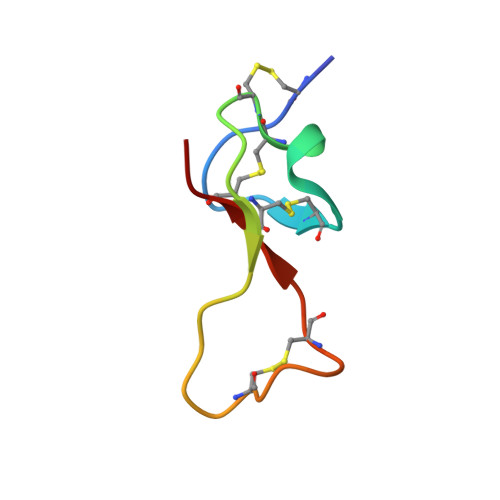The insecticidal neurotoxin Aps III is an atypical knottin peptide that potently blocks insect voltage-gated sodium channels.
Bende, N.S., Kang, E., Herzig, V., Bosmans, F., Nicholson, G.M., Mobli, M., King, G.F.(2013) Biochem Pharmacol 85: 1542-1554
- PubMed: 23473802
- DOI: https://doi.org/10.1016/j.bcp.2013.02.030
- Primary Citation of Related Structures:
2M36 - PubMed Abstract:
One of the most potent insecticidal venom peptides described to date is Aps III from the venom of the trapdoor spider Apomastus schlingeri. Aps III is highly neurotoxic to lepidopteran crop pests, making it a promising candidate for bioinsecticide development. However, its disulfide-connectivity, three-dimensional structure, and mode of action have not been determined. Here we show that recombinant Aps III (rAps III) is an atypical knottin peptide; three of the disulfide bridges form a classical inhibitor cystine knot motif while the fourth disulfide acts as a molecular staple that restricts the flexibility of an unusually large β hairpin loop that often houses the pharmacophore in this class of toxins. We demonstrate that the irreversible paralysis induced in insects by rAps III results from a potent block of insect voltage-gated sodium channels. Channel block by rAps III is voltage-independent insofar as it occurs without significant alteration in the voltage-dependence of channel activation or steady-state inactivation. Thus, rAps III appears to be a pore blocker that plugs the outer vestibule of insect voltage-gated sodium channels. This mechanism of action contrasts strikingly with virtually all other sodium channel modulators isolated from spider venoms that act as gating modifiers by interacting with one or more of the four voltage-sensing domains of the channel.
Organizational Affiliation:
Institute for Molecular Bioscience, The University of Queensland, St Lucia, QLD 4072, Australia.














